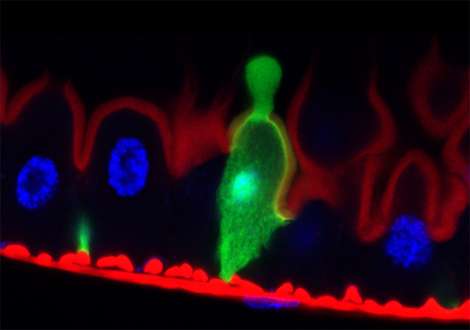Intestinal cells stave off bacteria by purging

Though purging is not prescribed as often as it was centuries ago, intestinal cells known as enterocytes frequently resort to this age-old remedy. Researchers from the Immune Response and Development in Insects (CNRS), Molecular Immunorheumatology (INSERM / Université de Strasbourg), and PAM Food Science and Microbiological Processes (AgroSup Dijon / Université de Bourgogne) laboratories have demonstrated that enterocytes attacked by pathogenic bacteria rapidly purge themselves of most of their contents. This protects them from infection and leads to a drastic though temporary thinning of the intestinal lining, or epithelium. This work, published on November 23 in Cell Host & Microbe, may eventually shed light on inflammatory bowel diseases like Crohn's disease.
Serratia marcescens is an opportunistic bacterium common throughout our environment. Drosophila flies fed a steady diet of S. marcescens die in days. However, analysis of the intestinal epithelium every 24 hours reveals no apparent damage. The researchers decided to study what happens during the first few hours after infection. They found that, during this initial period, the epithelium is remarkably thinner, and seems almost to have disappeared. But it recovers its original thickness in the hours that follow. Enterocytes lose much of their cytoplasm, having expelled most of their contents, though not their nuclei. These cells thereby rid themselves of damaged organelles, of some of the bacteria attempting to penetrate the intestinal wall, and bacterial toxins. This process leaves the epithelium temporarily thinner.
The presence of hemolysin, a bacterial toxin that forms pores in the membranes of its target cells, triggers cell purging. The researchers showed that a mutant strain of S. marcescens unable to secrete hemolysin is for this reason actually more virulent. Though the toxin is no longer at its disposal, its absence means the enterocytes are not triggered to initiate protective purging, and the bacteria can then damage the epithelium with other virulence factors. Further studies have shown that this thinning and regrowth of the intestinal epithelium is characteristic of bees, mice, and humans alike. More research will be necessary to determine the molecular mechanisms involved and, more broadly, whether anomalies in this process can help elucidate the causes of inflammatory bowel diseases like Crohn's disease.
More information: Enterocyte purge and rapid recovery is a resilience reaction of the gut epithelium to pore-forming toxin attack. Lee KZ, Lestradet M, Socha C, Schirmeier S, Schmitz A, Spenlé C, Lefebvre O, Keime C, Yamba WM, Bou Aoun R, Liegeois S, Shwab Y, Simon-Assmann, P, Dalle F, Ferrandon D. Cell Host Microbe. 23 Nov 2016.
Journal information: Cell Host & Microbe
Provided by CNRS

















